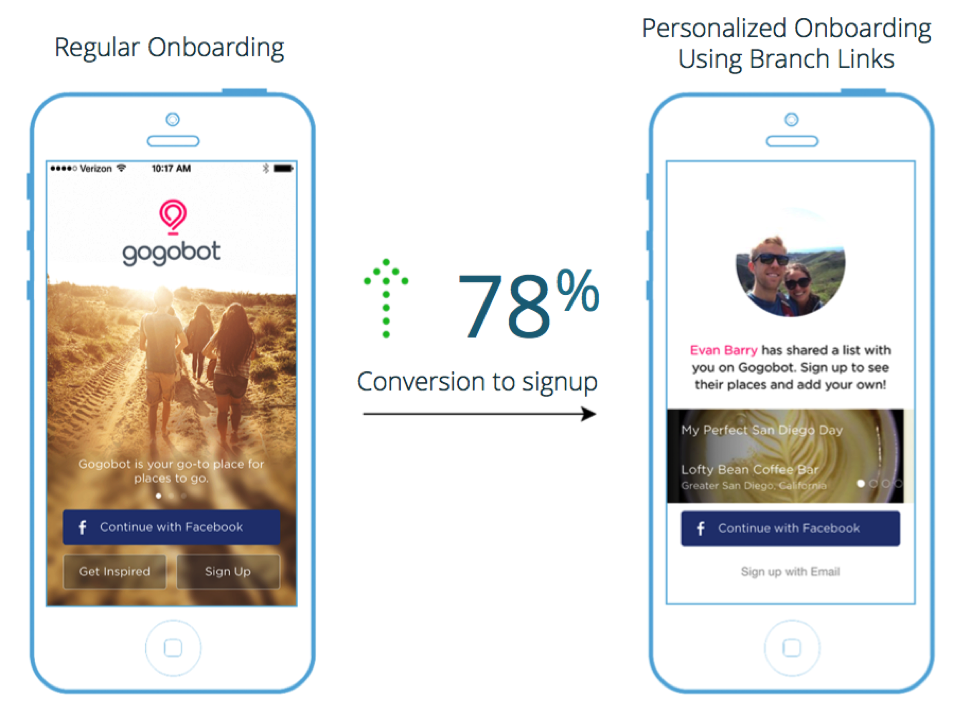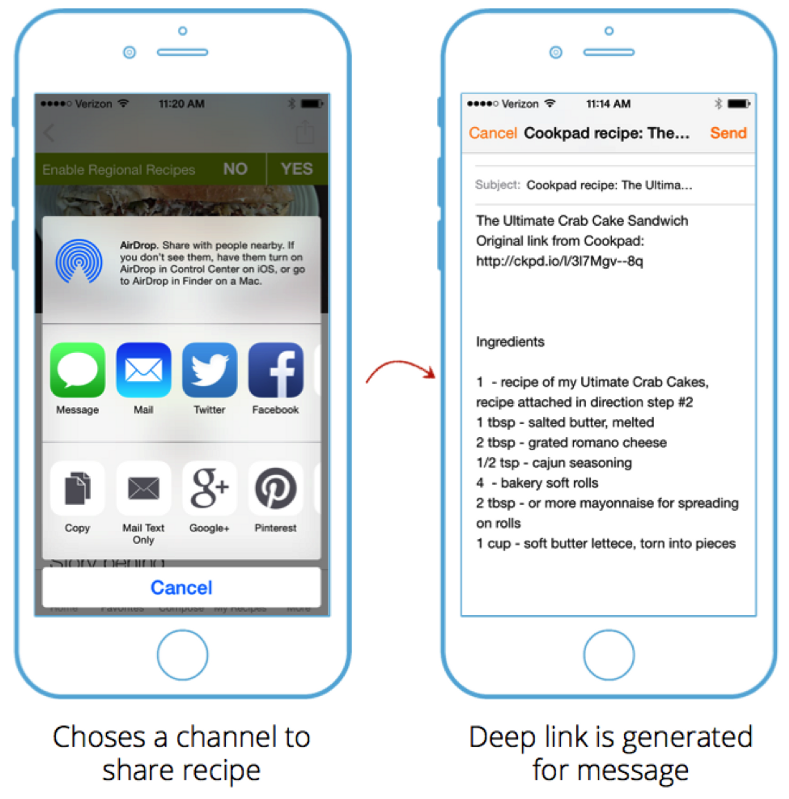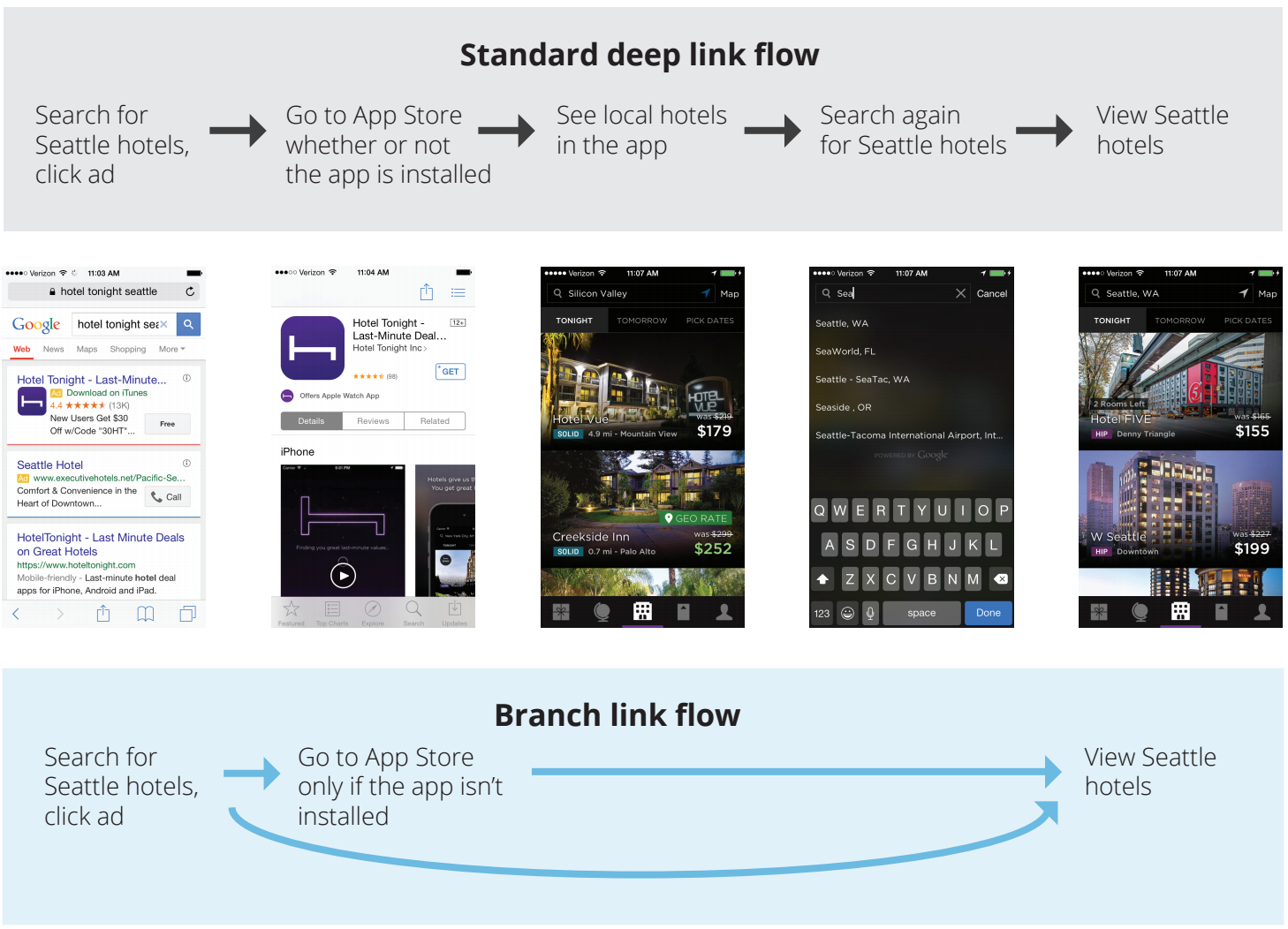How to Leverage Deep Linking to Turn Downloads Into Users
This is a guest post written by James Stuebner of Branch Metrics.
As a mobile app developer, you’re working hard to drive new users to your app. You’re focusing on creating meaningful ad campaigns, updating a mobile website, and sharing your app with every channel and person you come across. You’re investing hours into improving SEO and developing effective social media campaigns to help potential users download your app.
Your hard work is paying off – people know about your app and your installs are increasing. But your job isn’t done yet. To promote further growth and create a dedicated following, you need to solve a critical question: how can you ensure that the people who are hooked by your awareness campaigns continue to be engaged by your in-app content?
Attributing Installs
Before you can better engage your users, you need to know where your users are coming from, so you can customize the user experience to best fit their needs and interests. To do this, you’ll need to use a mobile attribution company like Branch, AppsFlyer, Adjust, or Kochava. Uniquely tagged deep links can help you to attribute clicks, downloads, and installs back to their sources.
Customizing the Onboarding Experience
Once you know where your users are coming from, you can customize the app experience to match people’s needs, interests, and expectations. Instead of giving everyone the same app tutorial and sign up process, take users directly to what they’re searching for. Mobile users are highly task-oriented and are all about efficiency. Every click a user has to make to reach engaging content increases the likelihood that they will get bored, distracted, or lose interest and exit the app.
One method to simplify and enhance a user’s onboarding experience is to pass data about users through install with a contextual deep link. Using a contextual deep link tells you how a user encountered a link, who referred them the link, whether they have a promo code, and really any other information you want to have about a user to improve their experience. Knowing where your user is coming from simplifies and enhances users’ sign up experiences and gives them a favorable first impression.
Engaging Referred Users
77% of app users arrive at an app because a friend recommends it to them. When they enter the app for the first time, they are expecting to see what they were shared.
Bring in a Friendly Face
One way to actively engage new users is to welcome them with a message from the friend that referred them as soon as the app is opened for the first time. For example, Gogobot uses a personalized welcome program to accompany their SMS referral program. Users who saw a personalized welcome from their friend were 78% more likely to register in the app. As a community based travel recommendation site, they implemented their sharing system to allow users who enjoy the app to invite their friends to sign up. Using a Branch link, they are able to personalize all downloads that result from an invite. Embedded in the link that potential users received from existing Gogobot users are the original user’s name, profile pic, and user ID.
When a new user downloads the Gogobot app from this link, Branch passes the original user’s name, profile picture, and user ID to the new app and creates a personal welcome screen inviting the new user to sign up. This slight change in the user experience nearly doubled the conversion from download to activation for referred users.

Activate and Engage Users Using Deep Linking
Another perk of using contextual deep links is to show users the content they are looking for immediately after install. Allthecooks found that users who originate from a deep link are 2.1x more likely to registers. By immediately satisfying mobile users – who are busy and easily distracted – with meaningful content, you can show them the benefits of using your app before they lose interest.
For Allthecooks, a community for sharing and discovering recipes, their best content is their recipes. Therefore, they want to make sure new users see a meaningful recipe right away. Their sharing program makes this possible. When a user wants to share a recipe, a Branch link is created that can easily be shared via text, email, Twitter, Facebook, or Pinterest.

This link is special because it directs users to the recipe inside the app right after opening, regardless of whether or not they have previously downloaded the app. It’s a frictionless experience.
Making User Registration Even Easier
Registering for an app can be a long process – one that can easily dissuade busy mobile users from continuing – but with contextual deep links, this process can be simplified. Users are more likely to continue through the sign-up process and become active users if there are less steps that they have to go through to register. Since personalizing their welcome process, Hotel Tonight has seen an 18% increase in install-to-booking conversion rates and a 16% drop in cost-per-install.
Hotel Tonight has created an easier registration process with the help of deep links for users that originate from their referral system. With their referrals, existing users can give new users a $25 discount on a hotel booking (they themselves receive the same discount as compensation). When a new user clicks on the link they have been shared, they are welcomed in the app by a page that tells them to sign up to get $25 off. Furthermore, in the sign up window, a promotional code is prepopulated – reassuring users that the discount they downloaded the app for will still be there after registration. By including a personalized message and prepopulating the promotional code field, users continue through the sign-up process and are more likely to remain active users. By including a personalized welcome experience Hotel Tonight has seen an astounding 99% increase in revenue.
Personalizing the Experience Using Unique Landing Pages
When you convince a user to download an app with an ad on mobile web, it is especially important that you engage them immediately because you’re spending money on a campaign or website. One way to actively engage users who click an app is to set up custom landing pages for different ad campaigns, taking users directly to what they want to see.
Hotel Tonight also uses deep links to create unique landing pages for users originating from ads. For example, a user searching for a hotel in Seattle who downloaded the app from the ad link would be introduced directly to hotels in Seattle upon their opening of the app for the first time.

Conclusion
By harnessing the power of contextual deep links, you have incorporated a friendly face for your user into your welcome screen, engaged users immediately with meaningful initial content, and simplified user registration. The better experience you provide users, the more likely they are more users stay with your app, the likelihood of them sharing your app with their network increases.
You work really hard to create the content that users download your app to find. It should be a no brainer that a user’s initial impression with your app should be incredible and should reflect their interests and desires. The first step towards unlocking the potential of a great onboarding experience is by incorporating contextual deep links.
To join the thousands of apps already using deep links, sign up at branch.io.
Thanks for
reading!
More articles you might be interested in:
How the Best Entertainment Apps Use UX to Hook Users
Entertainment apps make big bucks. Spotify and Apple Music generate over $7B in revenue. Netflix is close to breaking the $9B mark. And no one knows for certain how much YouTube makes, but estimates put it at higher than all of...
Read MoreHow to Gain and Engage Mobile Users
Is paid user acquisition the only way to get substantial users in this mobile ecosystem? Why even pay for downloads if those users don’t stick around? What are the best ways to create virality? Apptimize CEO, Nancy Hua, speaking at...
Read MoreHow Will Amazon Fire Affect Your App’s Users?
Amazon’s unveiling of their new phone has set the tech news world aflame today (yes, bad pun intended). While this is exciting news, app owners must wonder how this phone is going to affect users’ experience in every other retail...
Read More